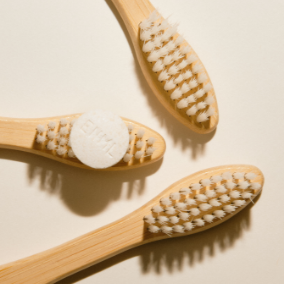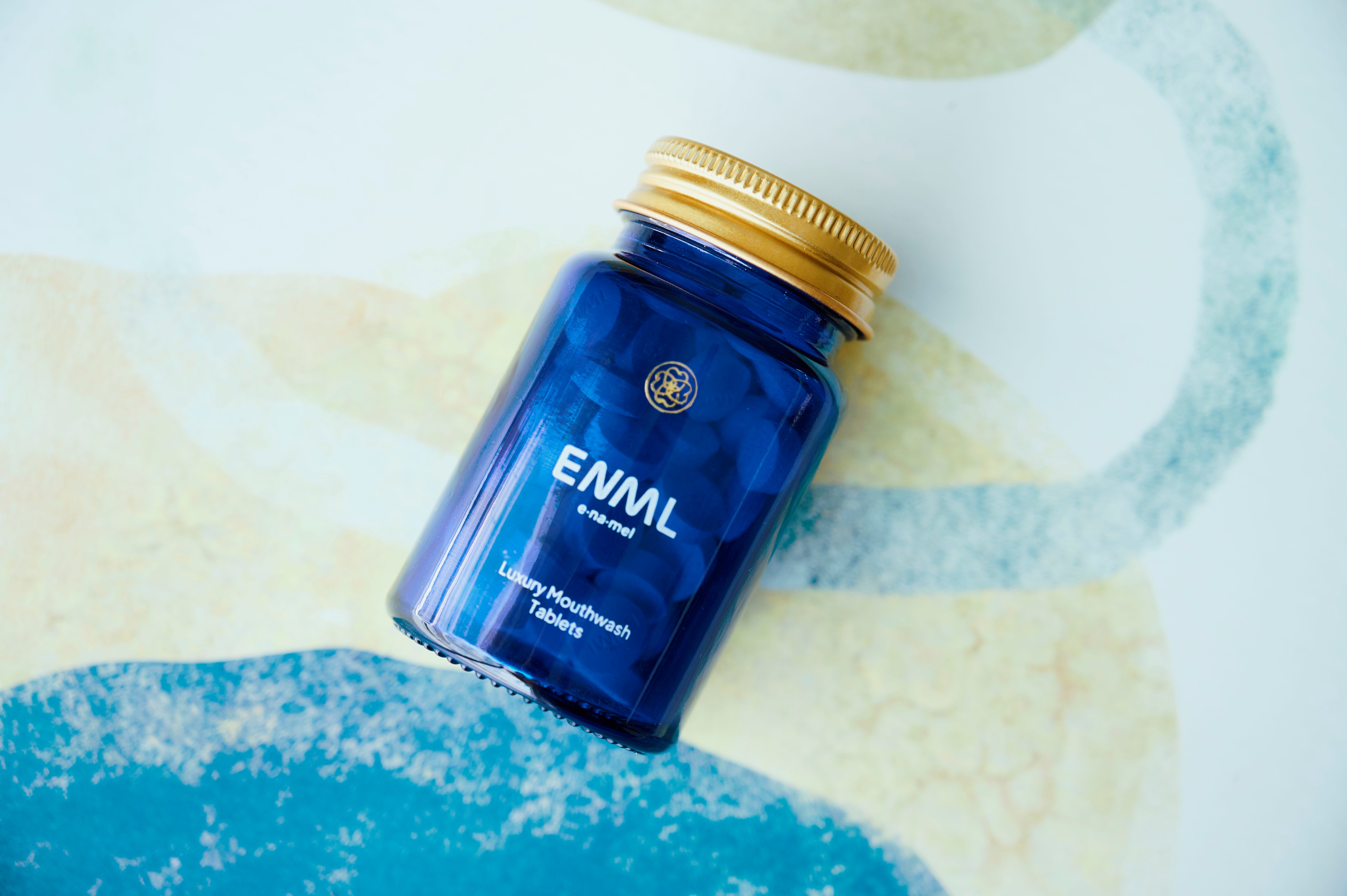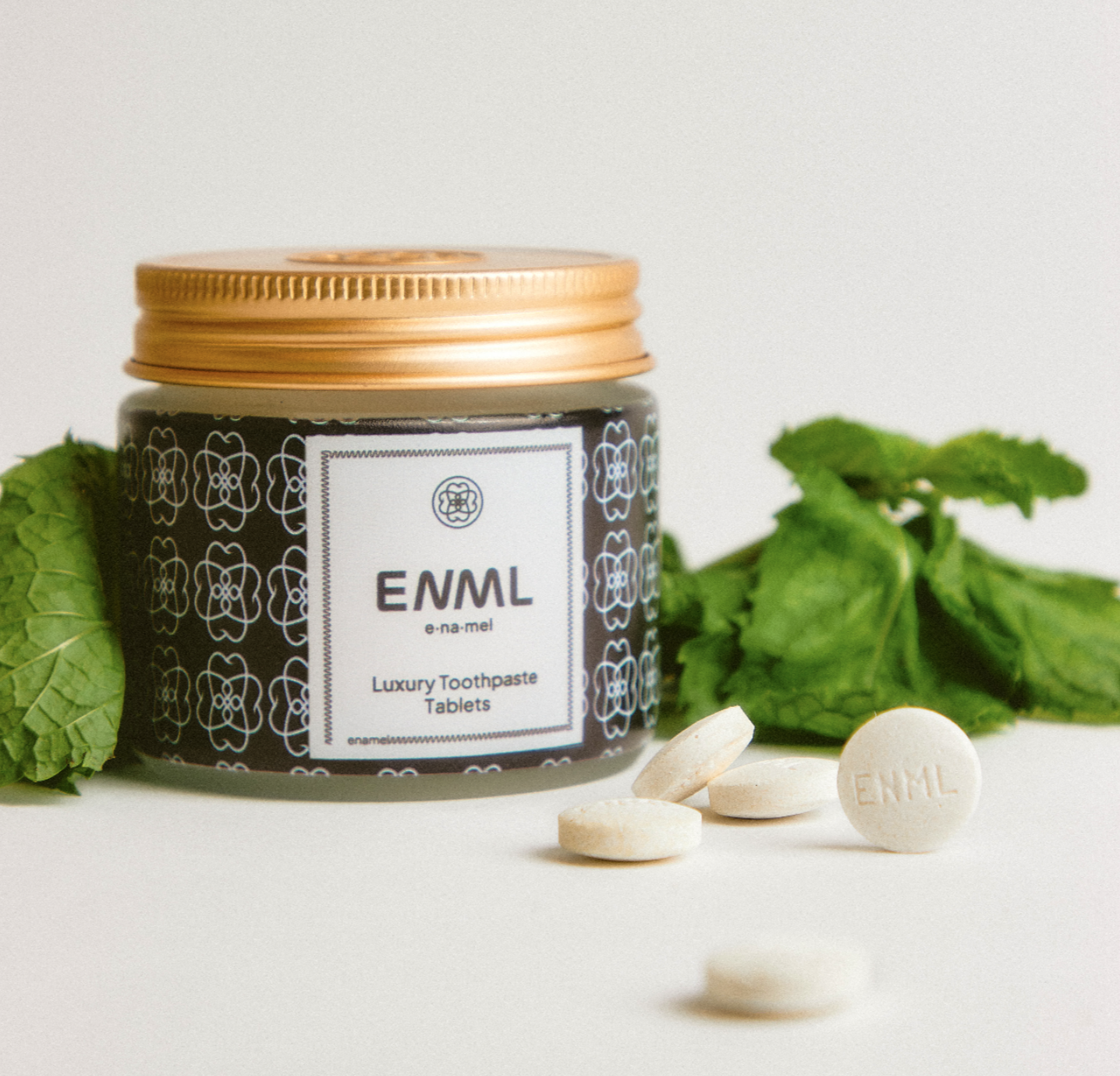Wincing at the thought of biting into an ice cream cone? You're not alone. Tooth sensitivity affects over 40% of adults worldwide, turning simple pleasures into painful experiences. Fortunately, specialized toothpaste can provide relief when used correctly, and ENML's innovative toothpaste tablets offer a unique, travel-friendly solution for those seeking to combat sensitivity without harsh chemicals.
Table of Contents
Understanding Tooth Sensitivity
Ever bite into an ice cream cone and feel a sharp zing in your teeth? You're not alone. Tooth sensitivity affects millions of people worldwide, making everyday activities like eating and drinking uncomfortable. Let's dive into why our teeth get sensitive and how special toothpastes can help.
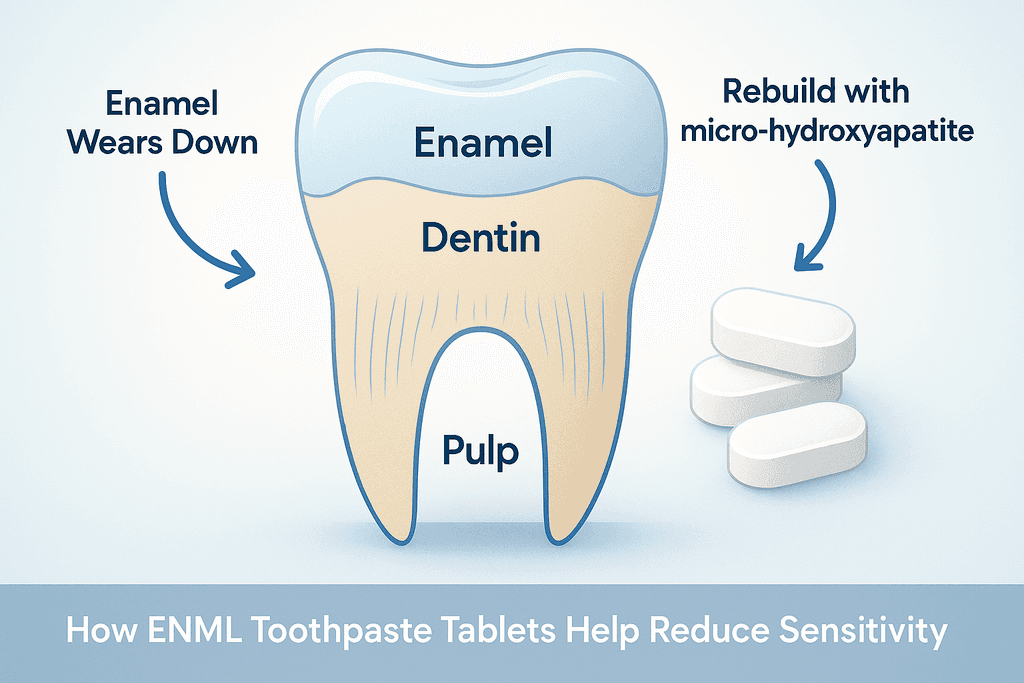
Tooth sensitivity often happens when the protective outer layer of our teeth (enamel) wears down. This exposes the softer, inner part (dentin) that's full of tiny tubes leading to the nerve center. When hot, cold, or sweet things touch these tubes, ouch! Here's what can cause this wear and tear:
- Brushing too hard
- Eating acidic foods
- Grinding teeth at night
- Gum recession
- Tooth decay
Sensitivity reduction toothpastes work by either blocking those tiny tubes or strengthening the enamel. Some common ingredients include:
- Potassium nitrate (numbs nerve endings)
- Strontium chloride (blocks tubules)
- Fluoride (strengthens enamel)
- Nano-hydroxyapatite (repairs enamel naturally)
Speaking of nano-hydroxyapatite, recent studies show it's a game-changer. A clinical study in Nature found that toothpaste with this ingredient significantly reduced sensitivity after just 2 weeks of use.
There are several types of sensitivity toothpastes out there:
- Traditional tubes with desensitizing ingredients
- Natural formulas without harsh chemicals
- Whitening options for sensitive teeth
- Toothpaste tablets (like ENML's) for eco-friendly sensitivity relief
Choosing the right one depends on your specific needs and preferences. Remember, consistency is key when using these products. It might take a few weeks to notice a difference, but your teeth will thank you!
| Sensitivity Cause | % of Cases |
|---|---|
| Tooth Wear | 45% |
| Gum Recession | 30% |
| Tooth Decay | 15% |
| Other | 10% |
Preparing for Sensitivity Reduction
If you're dealing with sensitive teeth, you're not alone. Many people experience that sharp zing when eating cold or hot foods. Before diving into using sensitivity reduction toothpaste, there are a few steps to take:
- Talk to your dentist: They can check if there's an underlying issue causing sensitivity
- Pick the right product: Look for toothpaste specifically designed for sensitive teeth
- Stick to a routine: Consistency is key in oral care
It's worth noting that not all sensitivity toothpastes are created equal. Some use potassium nitrate to block pain signals, while others, like ENML, use micro-hydroxyapatite to actually rebuild and strengthen enamel. This natural ingredient has been shown to effectively reduce sensitivity in clinical studies.
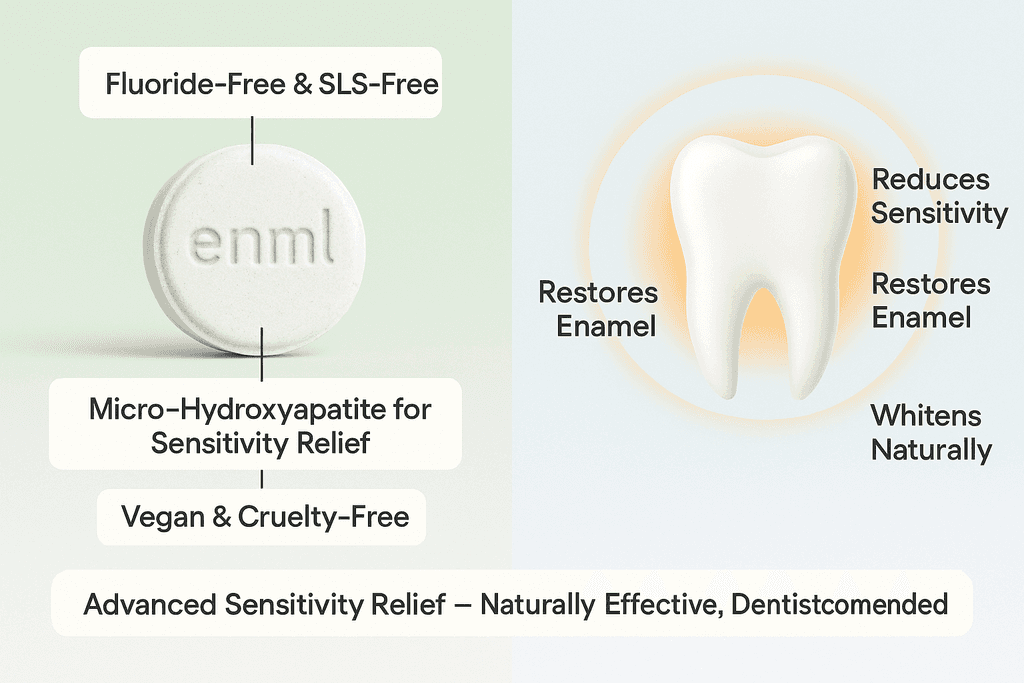
Choosing the Right Toothpaste
When selecting a sensitivity reduction toothpaste, consider these factors:
| Factor | Why It Matters |
|---|---|
| Active Ingredients | Different ingredients work in various ways to reduce sensitivity |
| Fluoride Content | Some prefer fluoride-free options for various reasons |
| Additional Benefits | Look for options that also whiten or freshen breath |
Remember, what works for one person might not work for another. It may take some trial and error to find the best option for your teeth.
Proper Application Techniques
Once you've chosen your sensitivity reduction toothpaste, using it correctly is crucial for the best results. Here's how to apply it effectively:
- Use a pea-sized amount of toothpaste
- Brush gently in circular motions
- Focus extra attention on sensitive areas
- Brush for at least two minutes
- Avoid rinsing immediately after brushing
Many dentists recommend leaving a thin layer of toothpaste on your teeth after brushing, especially at night. This allows the active ingredients more time to work their magic.
Targeted Application
For particularly sensitive spots, try this technique:
- Apply a small dab of toothpaste directly to the sensitive area
- Gently massage it in with your finger
- Leave it on for a few minutes before rinsing
This targeted approach can provide extra relief where you need it most. Some people find it helpful to do this before bed, allowing the toothpaste to work overnight.
Maximizing Effectiveness
To get the most out of your sensitivity reduction toothpaste, consider these tips:
| Tip | Benefit |
|---|---|
| Use consistently | Builds up protection over time |
| Avoid triggers | Gives teeth time to heal |
| Use a soft-bristled brush | Prevents further enamel wear |
Check out our entire collection
Learn MoreIt's also worth looking into complementary products. For instance, ENML offers toothpaste tablets with micro-hydroxyapatite, which can help rebuild enamel and reduce sensitivity over time.
Lifestyle Changes
While using sensitivity reduction toothpaste, consider making these adjustments:
- Limit acidic foods and drinks: These can wear away enamel
- Use a straw: When drinking cold or acidic beverages
- Wait to brush: After eating acidic foods, wait 30 minutes before brushing
Remember, reducing tooth sensitivity is a process. It may take a few weeks of consistent use to notice significant improvements. If sensitivity persists or worsens, it's important to consult with your dentist to rule out any underlying issues.
By following these steps and using a quality product like ENML's micro-hydroxyapatite toothpaste tablets, you're on your way to enjoying your favorite foods and drinks without that dreaded zing. Stick with it, and you'll likely find yourself smiling more comfortably in no time.
The ENML Advantage for Sensitive Teeth
When it comes to tackling tooth sensitivity, ENML's toothpaste tablets offer a fresh take on an old problem. Let's break down why these little tablets might be a game-changer for those wincing at ice cream or hot coffee.
Natural Ingredients Pack a Punch
ENML's approach to sensitivity reduction is all about harnessing nature's power. Their secret weapon? Micro-hydroxyapatite. This mineral is:
- Naturally occurring in our teeth and bones
- Scientifically proven to help remineralize enamel
- Effective at reducing sensitivity without harsh chemicals
By choosing ingredients that work with our bodies, ENML creates a gentler yet effective solution for sensitive teeth.
Eco-Friendly Without Compromise
ENML's commitment to the environment doesn't mean skimping on quality. Their tablets come in:
- Zero-waste packaging
- Compostable containers
- Refillable options
This eco-conscious approach means you can treat your sensitive teeth without adding to plastic waste. It's a win-win for your mouth and the planet.
Convenience Meets Consistency
The tablet form of ENML's toothpaste isn't just a gimmick. It's designed for:
- Easy travel - no more TSA liquid hassles
- Precise dosing - one tablet per brush
- Mess-free use - no more toothpaste tube squeezes
This convenience factor makes it easier to stick to a consistent oral care routine, which is key for managing sensitivity. Regular use is crucial for seeing results with any sensitivity reduction product, and ENML's tablets make that habit formation a breeze.
Recent research supports the effectiveness of desensitizing toothpastes in sealing dentin and reducing sensitivity. A study published in BMC Oral Health found that various desensitizing agents can effectively occlude dentinal tubules, leading to reduced sensitivity. This scientific backing aligns with ENML's approach, suggesting that their natural formulation could provide similar benefits.
While other brands might offer sensitivity toothpastes, ENML's combination of natural ingredients, eco-friendly packaging, and convenient tablet form sets them apart. For those new to sensitivity reduction toothpaste, ENML provides an accessible, effective, and sustainable option that doesn't require a complete overhaul of your brushing routine.
Embracing a Sensitivity-Free Smile
Using sensitivity reduction toothpaste doesn't have to be complicated. The key is to be consistent and patient. Remember to apply a pea-sized amount, brush gently, and avoid rinsing right after. Give it some time to work its magic.
If you're looking for a natural way to tackle tooth sensitivity, hydroxyapatite-based products are worth checking out. They help rebuild tooth enamel without harsh chemicals. Our ENML toothpaste tablets use this ingredient to gently clean and protect sensitive teeth.
Ready to say goodbye to wincing when you sip your morning coffee? Why not give a new approach a try? Your teeth (and taste buds) might thank you. For more tips on managing sensitive teeth, check out our guide on soothing sensitive teeth. And if you have questions, don't worry - we've got answers coming up in our FAQ section.
Common Questions About Sensitivity Reduction
How long does it take to see results?
Most people start noticing a difference in tooth sensitivity within 2-4 weeks of consistent use. However, everyone's teeth are different, so it may take up to 8 weeks for some individuals to experience significant relief. Stick with it and be patient - your teeth will thank you!
Can I use other toothpaste alongside sensitivity reduction products?
It's best to use sensitivity reduction toothpaste exclusively for optimal results. Mixing different types of toothpaste can dilute the effects of the desensitizing ingredients. If you're using ENML Toothpaste Tablets, they're formulated to provide comprehensive care, so there's no need for additional products.
Are there any side effects to using sensitivity reduction toothpaste?
Sensitivity reduction toothpastes are generally safe for daily use. Some people might experience temporary changes in taste perception or mild gum irritation when first starting. If you notice any persistent discomfort, it's always a good idea to consult with your dentist.
How often should I use sensitivity reduction toothpaste?
For best results, use sensitivity reduction toothpaste twice daily, just like your regular brushing routine. Consistency is key in managing tooth sensitivity. ENML Toothpaste Tablets make it easy to maintain this habit, even when you're on the go.
Can sensitivity reduction toothpaste help with all types of tooth sensitivity?
While sensitivity reduction toothpaste can address many common causes of tooth sensitivity, it may not be effective for all types. If you're experiencing severe or persistent sensitivity, it's important to see a dentist to rule out any underlying dental issues that might require different treatment.
Check out our entire collection
Learn More
